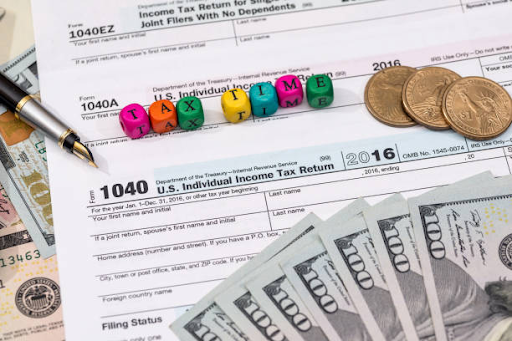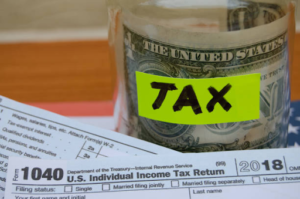- October 25, 2023
- Posted by: Marc Laguerrier
- Category: Blog

Ready to supercharge your retirement savings and pay less in taxes while you’re at it? Imagine retiring with not just a good nest egg, but a golden one! And all because you chose to make the most of your pre-tax contributions. If this sounds like a dream, well, it’s not. It’s an approachable reality. In this comprehensive guide, we will demystify pre-tax contributions, showing how you can maximize these tools to effectively lower your taxable income and accumulate more wealth for your golden years. Unveil the power of strategic tax planning— embrace financial wisdom, security and peace of mind for a prosperous tomorrow!
Pre-tax contributions refer to money contributed to a designated pension plan, retirement account, or tax-deferred investment vehicle before taxes are deducted. This reduces your taxable income for the current year and helps encourage saving for retirement. By taking advantage of pre-tax contributions into tax-advantaged accounts like traditional IRAs, 401(k) plans, and 403(b) plans, employees can reduce their taxable income and income tax owed each year. Making pre-tax contributions is generally beneficial as it defers payments and takes advantage of the time value of money.
Defining Pre-Tax Contributions
When it comes to maximizing your savings for retirement, understanding the concept of pre-tax contributions is crucial. Put simply, pre-tax contributions refer to the money you put into designated pension plans, retirement accounts, or tax-deferred investment vehicles before taxes are deducted from your income. This practice encourages individuals to save for retirement while simultaneously reducing their current year’s income tax burden.
Imagine you earn $75,000 per year with an effective tax rate of 24%. By contributing $15,000 to your 401(k) plan as a pre-tax contribution, your taxable income reduces to $60,000. As a result, you will have a lower tax liability and potentially more take-home pay at the end of the year.
It’s important to note that contributions to retirement savings plans can be both pre-tax and after-tax. After-tax contributions are made with money that has already been taxed. While this may seem counterintuitive at first glance, it might make sense if you anticipate higher tax rates in the future.
However, tax-advantaged accounts such as traditional Individual Retirement Accounts (IRAs), 401(k) plans, or 403(b) plans specifically allow individuals to contribute using income that has not been subject to payroll or income taxes. This ultimately reduces their taxable income and decreases the annual income tax owed.
Let’s say you contribute $5,000 to a traditional IRA as a pre-tax contribution and you’re currently in the 24% tax bracket. The amount contributed would be taxed only when withdrawn during retirement.
Making pre-tax contributions is generally beneficial as it defers payments and takes advantage of the time value of money. With these contributions remaining untouched until retirement, they have ample time to grow through compounding interest and potential market gains.
Now that we have a grasp on what pre-tax contributions are, let’s explore the vital role that employer contribution plans play in this financial strategy.
Role of Employer Contribution Plans
Employer contribution plans form an integral part of pre-tax contributions. Many employers offer these plans, such as 401(k) or 403(b) plans, to assist employees in saving for retirement. The primary distinguishing factor of these plans is that employees can contribute pre-tax dollars directly from their paychecks, reducing their taxable income.
One of the significant advantages of employer contribution plans is that some employers match a portion, or sometimes even all, of their employee’s contributions. This is essentially free money given to you by your employer as an incentive to save for retirement. It’s crucial to take advantage of this matching opportunity since it provides substantial growth potential for your savings.
For instance, let’s say your employer offers a 50% match on your contributions up to 6% of your salary. If you earn $60,000 per year and contribute the full 6%, which amounts to $3,600 annually, your employer will contribute an additional $1,800 to your retirement account. That’s an instant 50% return on investment!
In addition to the matching contribution advantage, contributions made through an employer-sponsored retirement plan benefit from tax deferral until withdrawals are ultimately made during retirement. This means you won’t be taxed on any earnings or gains made within the account until you start taking distributions.
Another essential aspect of employer contribution plans is that they allow for higher annual contribution limits compared to traditional IRAs. As of 2023, the maximum annual contribution limit for a 401(k) plan is $19,500, with an additional catch-up option of $6,500 if you’re over 50 years old. These higher limits enable individuals to save more for retirement and potentially achieve their financial goals faster.
Thus far, we have explored the definition of pre-tax contributions and the role that employer contribution plans play in maximizing your savings for retirement. Now, let’s delve into the advantages of making these pre-tax contributions.
Advantages of Pre-Tax Contributions
When it comes to planning for retirement, one of the most effective strategies is maximizing your savings through pre-tax contributions. These contributions offer several advantages that can significantly impact your financial future.
First and foremost, making pre-tax contributions allows you to reduce your current taxable income. By diverting a portion of your earnings into tax-advantaged accounts like traditional IRAs, 401(k) plans, or 403(b) plans, you effectively lower your taxable income for the year. This reduction in taxable income translates into a lower income tax liability, potentially putting more money back in your pocket.
Let’s consider an example to illustrate this advantage. Suppose you earn $75,000 annually and have an effective tax rate of 24%. By contributing $15,000 to your 401(k) plan as a pre-tax contribution, your taxable income would decrease to $60,000. This would result in a reduced tax liability by $3,600 ($15,000 * 0.24).
Furthermore, pre-tax contributions benefit from the time value of money. By deferring taxes on these contributions until retirement when you withdraw the funds, you allow them to grow and compound over time. The growth potential can be significant and provide substantial additional savings for your retirement nest egg.
Additionally, if you expect your current tax bracket to be higher than your retirement tax bracket or anticipate future increases in tax rates, making pre-tax contributions becomes even more advantageous. By taking advantage of lower tax rates now and paying taxes on withdrawals during retirement when you may have a lower income level or more favorable tax situation, you can optimize your overall tax burden.
Impact on Annual Taxes
Understanding the impact that pre-tax contributions can have on your annual taxes is essential to fully grasp their advantages. As mentioned earlier, making pre-tax contributions allows you to lower your taxable income.
By lowering your taxable income, you effectively reduce the amount of income subject to taxation. This reduction in taxable income not only lowers your current tax liability but can also potentially place you in a lower tax bracket, resulting in even more significant savings.
It’s important to note that the exact impact on your taxes will depend on various factors, including the amount of pre-tax contributions made, your overall income level, and applicable tax brackets. Each individual’s financial situation is unique, so it’s advisable to consult with a tax professional or financial advisor to determine the specific impact on your annual taxes.
Furthermore, it’s crucial to be mindful of how pre-tax contributions may affect other elements tied to your annual taxes. For example, lower taxable income resulting from pre-tax contributions can impact certain deductions or credits that are tied to adjusted gross income (AGI). These can include deductions for student loan interest payments or eligibility for certain tax credits like the Child Tax Credit or Earned Income Tax Credit. Therefore, it’s important to assess and understand how these contributions may affect your overall tax planning strategy.
Let’s consider an example where an individual earning $50,000 makes pre-tax contributions of $5,000. In this scenario, their taxable income would decrease to $45,000. Depending on their specific tax bracket and other factors, this reduction in taxable income could lead to lower tax liability and potentially create opportunities for additional deductions or credits.
It’s worth noting that while pre-tax contributions offer immediate tax benefits by reducing current tax liability, taxes will eventually be due when you withdraw funds during retirement. However, strategies like diversifying retirement accounts with both pre-tax and after-tax (Roth) contributions can provide flexibility in managing future tax implications.
- According to a 2020 survey by the Investment Company Institute, about 56% of US households own a retirement account that allows for pre-tax contributions.
- The Bureau of Labor Statistics reported in 2021 that 62% of civilian workers have access to a defined contribution retirement savings plan, such as a 401(k) or similar plan, which accepts pre-tax contributions.
- A report from Vanguard in 2022 stated that employees who made pre-tax contributions lowered their annual tax bill by an average of $1,200.
Determining Eligibility for Pre-Tax Contributions
Before diving into the world of pre-tax contributions, it’s crucial to determine eligibility. Not everyone can take advantage of this retirement savings option, as it is mainly offered through employer-sponsored plans such as a 401(k) or 403(b). The first step is to check if your employer provides these plans and if you are eligible to participate in them.
If you are fortunate enough to have access to an employer-sponsored retirement plan, the next consideration is whether the plan offers pre-tax contributions. In recent years, the availability of Roth accounts within 401(k) plans has increased significantly. Roughly 88% of 401(k) plans offered Roth accounts in 2021, nearly double from a decade ago. This means that while pre-tax contributions are still prevalent, there may be options for after-tax Roth contributions within your plan as well.
To determine your eligibility for pre-tax contributions, review the plan documents provided by your employer. These documents will outline whether pre-tax contributions are allowed and any limits or restrictions that may apply. It’s important to note that contribution limits may vary each year based on IRS regulations.
Additionally, factors such as employment status (e.g., full-time or part-time), length of service with the company, and age requirements may also impact eligibility for making pre-tax contributions. Some employers have strict rules about when employees can begin participating in their retirement plans or when they become eligible for employer matching contributions.
Analyzing Pre-Tax vs Tax-Deferred Options
Now that you’ve determined your eligibility for pre-tax contributions, the next step is to analyze whether pre-tax or tax-deferred options align better with your retirement savings goals and financial situation. Making this decision requires careful consideration of several factors.
One critical factor influencing the choice between pre-tax and tax-deferred options is your current and expected future tax bracket. Pre-tax contributions offer an upfront tax break since they are deducted from your income before taxes are assessed. This reduces your taxable income, effectively lowering your current tax liability. For higher earners in a higher tax bracket, this immediate tax benefit may be attractive and can potentially result in significant savings.
However, it’s essential to consider the potential impact of future taxes on your retirement savings. With pre-tax contributions, the funds grow tax-deferred, meaning you will have to pay taxes on both the contributions and any investment gains when you withdraw during retirement. If you anticipate being in a lower tax bracket after retirement, then pre-tax contributions may still make sense.
On the other hand, tax-deferred options like Roth contributions offer an attractive alternative for those who anticipate being in a higher tax bracket in retirement. While Roth contributions are made with after-tax dollars, qualified withdrawals during retirement are entirely tax-free. This can be advantageous for individuals who expect their income and therefore their tax rate to increase over time.
To illustrate, let’s consider two individuals – Emily and Michael. They both have access to employer-sponsored retirement plans and are currently in the same tax bracket. Emily decides to maximize her pre-tax contributions because she expects a reduced income level in retirement. On the other hand, Michael chooses to make Roth contributions as he anticipates a higher income in his golden years.
Think of it like planting seeds for different crops in your garden – some plants thrive better in sunlight (pre-tax) while others flourish in shade (tax-deferred). It all depends on the specific conditions and goals you have for your retirement savings.
It’s worth noting that recent changes from Secure 2.0 have made Roth 401(k) contributions more appealing for some investors. The legislation now allows for employer matches on Roth contributions. Additionally, required minimum distributions (RMDs) are not required for Roth accounts during the account owner’s lifetime.
Ultimately, the decision between pre-tax and tax-deferred options depends on your income, current and future tax brackets, personal financial goals, and the flexibility offered by your employer-sponsored retirement plan.
Factors Influencing Retirement Savings Choice
When it comes to choosing between pre-tax and after-tax retirement savings options, several factors come into play. Your financial situation, current and expected future tax rates, and your retirement goals all contribute to the decision-making process. Let’s explore some of the key factors that influence your retirement savings choice.
- Current Tax Brackets: One of the primary considerations when deciding between pre-tax and after-tax contributions is your current income tax bracket. If you are in a higher tax bracket now and expect to be in a lower bracket during retirement, making pre-tax contributions would save you more money overall. On the other hand, if you’re currently in a lower tax bracket but anticipate being in a higher bracket later on, after-tax contributions might be more advantageous as they allow you to pay taxes at the current lower rate.
For instance, let’s say you’re currently earning $75,000 with an effective tax rate of 24%. By contributing $15,000 to your pre-tax 401(k) plan, your taxable income decreases to $60,000. This not only reduces your current income tax liability but also allows those savings to grow tax-deferred until withdrawal during retirement.
- Future Tax Implications: Although predicting future tax rates can be challenging, it is worth considering how they may change over time. Speculation suggests that tax rates may increase in the future due to various economic factors or changes in government policies. If you believe taxes will rise significantly in the coming years, making pre-tax contributions now can help maximize your savings by deferring taxes until retirement when you may be in a lower bracket.
- Employer Contributions: Another crucial factor to consider is whether your employer offers matching contributions to your retirement account. Employer matches are typically made on pre-tax contributions. Thus, participating in such programs enables you to maximize employer contributions while reducing your taxable income.
- Flexibility and Diversification: It’s important to strike a balance between pre-tax and after-tax contributions to ensure flexibility and diversification in retirement savings. Having a mix of pre-tax and after-tax accounts can provide a hedge against potential changes in tax laws and future uncertainty. This way, you have options available to manage your tax liability efficiently when you reach retirement age.
While it may seem logical to solely focus on pre-tax contributions, it’s essential to consider the benefits of after-tax contributions as well. After-tax contributions can provide more flexibility during retirement, as withdrawals from these accounts are generally tax-free. Additionally, if you anticipate higher income levels in the future that might push you into a higher tax bracket, making after-tax contributions now could be advantageous.
Ultimately, the decision between pre-tax and after-tax retirement savings depends on your individual circumstances. Assessing your current tax situation, expected future tax rates, employer contributions, and overall flexibility will help guide your choice. Consulting with a financial advisor can also provide valuable insights tailored to your specific needs and goals. Remember, building a comprehensive retirement savings strategy takes careful consideration of all these factors to maximize your savings potential.
Beyond Numbers: Americ Tax – Your Gateway to Exceptional Tax Preparation and Financial Empowerment
Are you ready to redefine your tax preparation experience and embrace a level of service that transcends the ordinary? Look no further than Americ Tax, the epitome of excellence in tax preparation services. As you navigate the complex landscape of financial obligations, Americ Tax stands as your beacon of expertise, offering a seamless and comprehensive solution for individuals and businesses alike. Our team of seasoned professionals isn’t just here to crunch numbers; we’re here to elevate your financial well-being.
What sets Americ Tax apart is our commitment to delivering results beyond expectation. We understand that each financial journey is unique, and our approach reflects that understanding. Whether you’re a first-time filer or a seasoned taxpayer, Americ Tax tailors its strategies to suit your specific needs. Our platform isn’t just a space for transactional processes; it’s a hub of empowerment, designed to equip you with the knowledge and tools necessary to make informed financial decisions.
At Americ Tax, we don’t just follow trends; we set them. Our experts stay ahead of the curve, ensuring that you benefit from the latest tax laws, credits, and deductions available. Your financial success is our priority, and we take pride in being more than just a service provider—we are your partners in financial prosperity.
Say goodbye to the stress and confusion of tax season. Experience the Americ Tax advantage by visiting https://americtax.com/. Our user-friendly platform, coupled with unmatched expertise, awaits you. Book an appointment or contact us at 678-531-0831. Let Americ Tax be your trusted ally on the path to financial success. Your journey to stress-free and effective tax preparation starts here!







